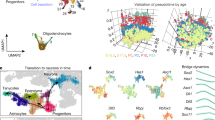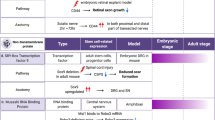Abstract
Here we summarize recent findings on the biology of hepatocyte growth factor (HGF, also known as scatter factor), focusing on its effects on developing neurons. HGF is both a chemoattractant and a survival factor for embryonic motor neurons. In addition, sensory and sympathetic neurons and their precursors respond to HGF with increased differentiation, survival and axonal outgrowth. The broad spectrum of HGF activities and its observed synergy with other neurotrophic factors suggest that the major role of HGF is to potentiate the response of developing neurons to specific signals.
This is a preview of subscription content, access via your institution
Access options
Subscribe to this journal
Receive 12 print issues and online access
$209.00 per year
only $17.42 per issue
Buy this article
- Purchase on Springer Link
- Instant access to full article PDF
Prices may be subject to local taxes which are calculated during checkout


Similar content being viewed by others
References
Birchmeier, C. & Gherardi, E. Developmental roles of HGF/SF and its receptor, the c-Met tyrosine kinase. Trends Cell Biol. 8, 404–410 (1998).
Birchmeier, W. et al. Role of HGF/SF and c-met in morphogenesis and metastasis of epithelial cells. Ciba Found. Symp. 212, 230–240 (1997).
Jeffers, M., Rong, S. & Vande Woude, G. F. Hepatocyte growth factor/scatter factor - Met signaling in tumorigenesis and invasion/metastasis. J. Mol. Med. 74, 505–513 (1996).
Streit, A. et al. A role for HGF/SF in neuronal induction and its expression in Hensen's node during gastrulation. Development 121, 813–824 (1995).
Streit, A. et al. Preventing the loss of competence for neural induction: HGF/SF, L5 and Sox-2. Development 124, 1191– 1202 (1997).
Schmidt, C. et al. Scatter factor/hepatocyte growth factor is essential for liver development. Nature 373, 699– 702 (1995).
Uehara, Y. et al. Placental defect and embryonic lethality in mice lacking hepatocyte growth factor/scatter factor. Nature 373, 702–705 (1995).
Bladt, F., Riethmacher, D., Isenmann, S., Aguzzi, A. & Birchmeier, C. Essential role for the c- met receptor in the migration of myogenic precursor cells into the limb bud. Nature 376, 768–771 (1995).
Maina, F. et al. Uncoupling of Grb2 from the Met receptor in vivo reveals complex roles in muscle development. Cell 87, 531 –542 (1996).
Sonnenberg, E., Meyer, D., Weidner, K. M. & Birchmeier, C. Scatter factor/hepatocyte growth factor and its receptor, the c-met tyrosine kinase, can mediate a signal exchange between mesenchyme and epithelia during mouse development. J. Cell Biol. 123, 223 –235 (1993).
Jung, W. et al. Expression and functional interaction of hepatocyte growth factor-scatter factor and its receptor c-met in mammalian brain. J. Cell Biol. 126, 485–494 ( 1994).
Achim, C. L. et al. Expression of HGF and c-Met in the developing and adult brain. Dev. Brain Res. 102, 299– 303 (1997).
Thewke, D. P. & Seeds, N. W. Expression of hepatocyte growth factor/scatter factor, its receptor, c-Met, and tissue-type plasminogen activator during development of the murine olfactory system. J. Neurosci. 16, 6933–6944 ( 1996).
Hamanoue, M. et al. Neurotrophic effect of hepatocyte growth factor on central nervous system neurons in vitro. J. Neurosci. Res. 43, 554–564 (1996).
Di Renzo, M. F. et al. Selective expression of the Met/HGF receptor in human central nervous system microglia. Oncogene 8, 219 –222 (1993).
Krasnoselsky, A. et al. Hepatocyte growth factor is a mitogen for Schwann cells and is present in neurofibromas. J. Neurosci. 14, 7284–7290 (1994).
Ebens, A. et al. Hepatocyte growth factor/Scatter factor is an axonal chemoattractant and a neurotrophic factor for spinal motor neurons. Neuron 17, 1157–1172 (1996).
Maina, F., Hilton, M. C., Ponzetto, C., Davies, A. M. & Klein, R. Met receptor signaling is required for sensory nerve development and HGF promotes axonal growth and survival of sensory neurons. Genes Devel. 11, 3341 –3350 (1997).
Wong, V. et al. Hepatocyte growth factor promotes motor neuron survival and synergizes with ciliary neurotrophic factor. J. Biol. Chem. 272 , 5187–5191 (1997).
Yamamoto, Y. et al. Hepatocyte growth factor (HGF/SF) is an essential muscle-derived survival factor for a subpopulation of embryonic motoneurons. Development 124, 2903–2913 (1997).
Oppenheim, R. W. Neurotrophic survival molecules for motoneurons: an embarrassment of riches. Neuron 17, 195–197 (1996).
Fagan, A. M. et al. TrkA, but not TrkC, receptors are essential for survival of sympathetic neurons in vivo. J. Neurosci. 16, 6208–6218 (1996).
Wyatt, S., Pinon, L. G. P., Ernfors, P. & Davies, A. M. Sympathetic neuron survival and TrkA expression in NT-3-deficient mouse embryos. EMBO J. 16, 3115–3123 (1997).
Maina, F. et al. Multiple roles for hepatocyte growth factor in sympathetic neuron development. Neuron 20, 835– 846 (1998).
Yang, X.-M. et al. Autocrine hepatocyte growth factor provides a local mechanism for promoting axonal growth. J. Neurosci. 18, 8369–8381 (1998).
Ponzetto, C. et al. A multifunctional docking site mediates signaling and transformation by the hepatocyte growth factor/scatter factor receptor family. Cell 77, 261–271 ( 1994).
Boccaccio, C. et al. Induction of epithelial tubules by growth factor HGF depends on the STAT pathway. Nature 391, 285– 288 (1998).
Weidner, K. M. et al. . Interaction between Gab1 and the c-Met receptor tyrosine kinase is responsible for epithelial morphogenesis. Nature 384, 173–176 (1996).
Rodrigues, G. A., Park, M. & Schlessinger, J. Activation of the JNK pathway is essential for transformation by the Met oncogene. EMBO J. 16, 2634– 2645 (1997).
Nguyen, L. et al. Association of the multisubstrate docking protein Gab1 with the hepatocyte growth factor receptor requires a functional Grb2 binding site involving tyrosine 1356. J. Biol. Chem. 272, 20811–20819 (1997).
Kochhar, K. S. & Iyer, A. P. Hepatocyte growth factor induces activation of Nck and phospholipase C-gamma in lung carcinoma cells. Cancer Lett. 12, 163– 169 (1996).
Chen, H. C., Chan, P. C., Tang, M. J., Cheng, C. H. & Chang, T. J. Tyrosine phosphorylation of focal adhesion kinase stimulated by hepatocyte growth factor leads to mitogen-activated protein kinase activation. J. Biol. Chem. 273, 25777 –25782 (1998).
Monard, D. Cell-derived proteases and protease inhibitors are regulators of neurite outgrowth. Trends Neurosci. 11, 541– 544 (1988).
Pittman, R. N. & Buettner, H. M. Degradation of extracellular matrix by neuronal proteases. Dev. Neurosci. 11, 361–375 (1989).
Rong, S. et al. Tumorigenesis induced by co-expression of human hepatocyte growth factor and the human met protooncogene leads to high levels of expression of the ligand and receptor. Cell Growth Differ. 4, 563–569 (1993).
Ponzetto, C. et al. Specific uncoupling of GRB2 from the Met receptor: differential effect on transformation and motility. J. Biol. Chem. 271, 14119–14123 (1996).
Royal, I. & Park, M. Hepatocyte growth factor-induced scatter of Madin-Darby canine kidney cells requires phosphatidylinositol 3-kinase. J. Biol. Chem. 270, 27780– 27787 (1995).
Ridley, A. J., Comoglio, P. M. & Hall, A. Regulation of scatter factor/hepatocyte growth factor responces by Ras, Rac, and Rho in MDCK cells. Mol. Cell. Biol. 15, 1110–1122 ( 1995).
Hartmann, G., Weidner, K. M., Schwarz, H. & Birchmeier, W. The motility signal of scatter factor/hepatocyte growth factor mediated through the receptor tyrosine kinase Met requires intracellular action of Ras. J. Cell. Biol. 269, 21936–21939 (1994).
Barinaga, M. Neurotrophic factors enter the clinic. Science 264, 772–774 (1994).
Lindvall, O. & Odin, P. Clinical application of cell transplantation and neurotrophic factors in CNS disorders. Curr. Opin. Neurobiol. 4, 752–757 ( 1994).
Schatzl, H. M. Neurotrophic factor: ready to go? Trends Neurosci. 18, 463–464 (1995).
Nishi, R. Neurotrophic factors: two are better than one. Science 265, 1052–1053 (1994).
Tuszynski, M. H., Roberts, J., Senut, M. C. & Gage, F. H. Gene therapy in the adult primate brain: intraparenchymal grafts of cells genetically modified to produce nerve growth factor prevent cholinergic neuronal degeneration. Gene Ther. 3, 305– 314 (1996).
Martinez-Serrano, A., Fischer, W. & Bjorklund, A. Reversal of age-dependent cognitive impairments and cholinergic neuron atrophy by NGF-secreting neural progenitors grafted to the basal forebrain. Neuron 15, 473– 484 (1995).
Apfel, S. C., Lipson, L., Arezzo, J. C. & Kessler, J. A. Nerve growth factor prevents neuropathy in mice. Ann. Neurol. 29, 87–90 (1991).
Apfel, S. C., Arezzo, J. C., Brownlee, M., Federoff, H. & Kessler, J. A. Nerve growth factor administration protects against experimental diabetic sensory neuropathy. Brain Res. 634, 7–12 ( 1994).
Shiota, G., Wang, T.C., Nakamura, T. & Schmidt, E. V. Hepatocyte growth factor in transgenic mice: Effects on hepatocyte growth, liver regeneration and gene expression. Hepatology 19, 962– 972 (1994).
Allen, R. E., Sheenan, S. M., Taylor, R. G., Kendall, T. L. & Rice, G. M. Hepatocyte growth factor activates quiescent skeletal muscle satellite cells in vitro. J. Cell Physiol. 165, 307–312 ( 1995).
Ueki, T., et al. Hepatocyte growth factor gene therapy of liver cirrhosis in rats. Nat. Med. 5, 226–230 (1999).
Acknowledgements
We are grateful to F. Helmbacher for assistance with figures, and to F. Helmbacher, R. Dono, G. Wilkinson, and K. Kullander for comments on the manuscript. F.M. is supported by a grant from the DFG (SFB 317). Our own work is in part supported by an EU Biotechnology network grant.
Author information
Authors and Affiliations
Corresponding authors
Rights and permissions
About this article
Cite this article
Maina, F., Klein, R. Hepatocyte growth factor, a versatile signal for developing neurons. Nat Neurosci 2, 213–217 (1999). https://doi.org/10.1038/6310
Received:
Accepted:
Issue Date:
DOI: https://doi.org/10.1038/6310
This article is cited by
-
Associations of the cerebrospinal fluid hepatocyte growth factor with Alzheimer’s disease pathology and cognitive function
BMC Neurology (2021)
-
The sympathetic nervous system in development and disease
Nature Reviews Neuroscience (2021)
-
c-Met is expressed by highly autoreactive encephalitogenic CD8+ cells
Journal of Neuroinflammation (2020)
-
Intrathecal delivery of recombinant AAV1 encoding hepatocyte growth factor improves motor functions and protects neuromuscular system in the nerve crush and SOD1-G93A transgenic mouse models
Acta Neuropathologica Communications (2019)
-
Hepatocyte Growth Factor (HGF) Promotes Peripheral Nerve Regeneration by Activating Repair Schwann Cells
Scientific Reports (2018)



